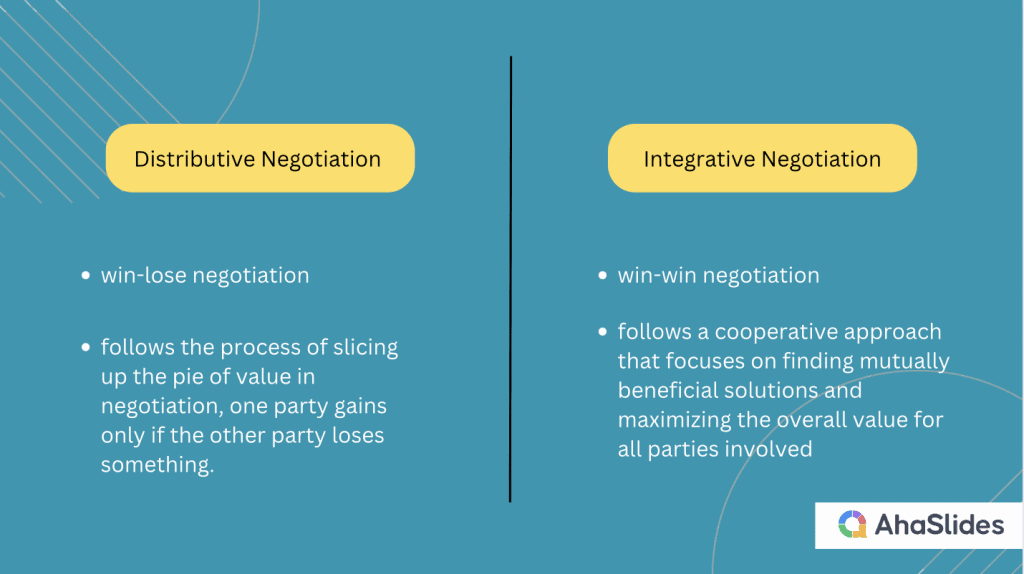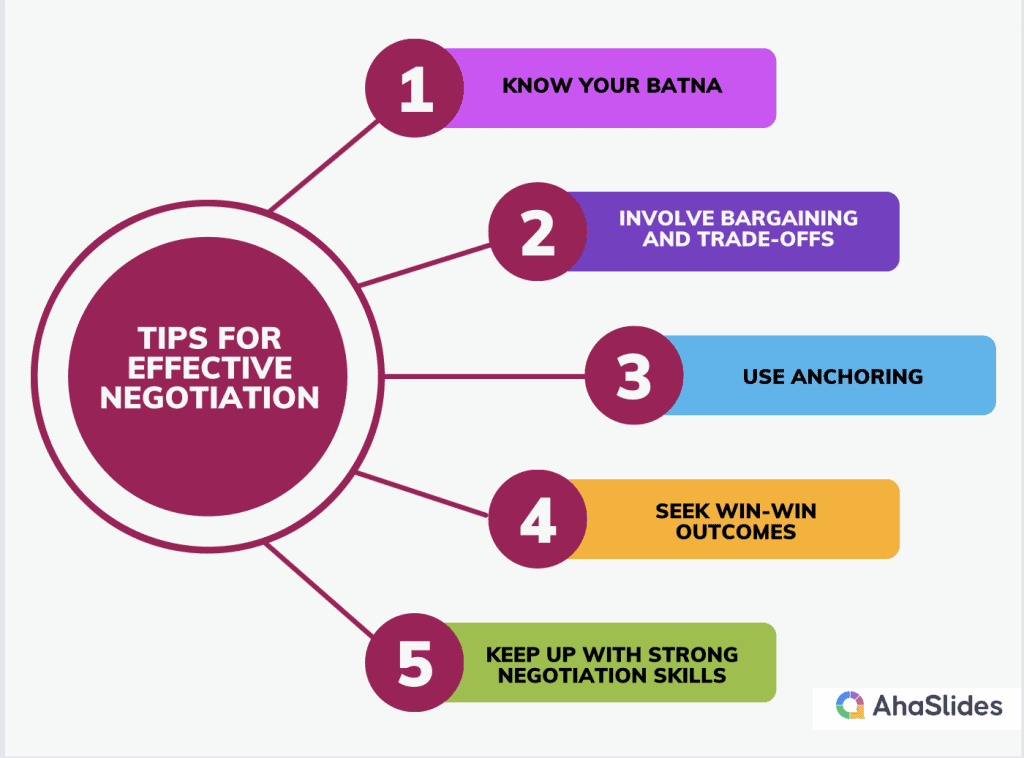In the dynamic world of business, negotiation is omnipresent and indispensable. Whether it's securing favorable contracts, resolving conflicts, or fostering collaborations, negotiation is the gateway to progress.
Negotiation empowers businesses to navigate complex challenges, seize opportunities, and create win-win situations.
However, different types of contexts might need an adoption of certain types of negotiation.
In this article, we aim to shed light on 10 different types of negotiation strategies with their key principles to find out the best fit for your organization's upcoming bargains.

Table of Contents
- What is Negotiation and its Importance?
- What are the 10 Types of Negotiation and Examples?
- How to Implement Effective Negotiation?
- Frequently Asked Questions
- Bottom Line
What is Negotiation and its Importance?
Negotiation is a dynamic and interactive process that refers to two or more parties engaging in discussions and deliberations to reach a mutually satisfactory agreement or resolution.
With many advantages, negotiation enables businesses to:
- Forge strong partnerships
- Drive growth and innovation
- Achieve optimal deals
- Resolve disputes
- Foster collaboration
What are the 10 Types of Negotiation and Examples?
It is time to take a deeper understanding of different types of negotiation strategy. Each style comes with some key principles and examples on when to use.
#1. Distributive Negotiation
Distributive types of negotiation, or win-lose negotiation, is one of the most popular types of negotiation where the parties involved are primarily focused on claiming the largest possible share of the available resources or achieving their own individual objectives.
It is characterized by a strongly competitive mindset, within the positional negotiation approach, "fixed-pie” negotiation, or Zero-Sum Game meaning any gain by one party directly results in a corresponding loss for the other party.
For example, types of negotiation like distributive style can be used strategically in certain situations, such as price negotiations, auctions, or when there are limited resources.
#2. Integrative Negotiation
One of the best types of negotiation, Integrative negotiation, also called collaborative or win-win business negotiation tactics, is quite the opposite of Distributive negotiation. This style follows a cooperative approach that focuses on finding mutually beneficial solutions and maximizing the overall value for all parties involved. It aims to create outcomes where both sides can achieve their objectives and address their underlying interests.
For example, integrative types of negotiation are effective when dealing with long-term relationships or anticipating future interactions among many parties, such as business partnerships, vendor-client relationships, or employer-employee relationships.

#3. Avoiding Negotiation
Avoiding negotiations, also known as the avoidance strategy, are types of negotiation approach where one or both parties choose to avoid or delay engaging in the negotiation process altogether. Instead of actively seeking a resolution or reaching an agreement, parties may decide to ignore the issue, postpone discussions, or find alternative ways to address the situation.
For example, if parties feel unprepared, lack sufficient information, or require more time to gather data and analyze the situation, avoidance types of negotiation may be a temporary strategy to allow for adequate preparation.
#4. Multiparty negotiation
Multiparty negotiation refers to a negotiation process that involves three or more parties working together to reach an agreement or resolve a complex issue. Unlike two-party negotiations, where two entities directly interact, multiparty negotiations require managing the dynamics, interests, and interactions among multiple stakeholders.
Multiparty negotiations can be found in various contexts, such as international diplomacy, business partnerships, community planning, or governmental decision-making.
#5. Compromising Negotiation
Compromising is a type of negotiation that follows a middle ground approach where both parties try to give up certain parts of what they want to achieve an overall agreement. It demonstrates a willingness of each party to find common ground and accommodate each other's interests,
Compromising types of negotiation are often used in situations where maintaining relationships, reaching a timely resolution, or striking a fair compromise are considered important.
#6. Accommodating/Conceding Negotiation
When negotiators prioritize building a strong goodwill between the negotiating parties while minimizing conflicts, they are doing an accommodating type of negotiation. The key principle of this style is a focus on meeting interests and needs of the other party over one's own.
The types of negotiation are frequently utilized in the case of long-term business partnerships, strategic alliances, or collaborations.
#7. Principled Negotiation
Among many common types of negotiation, principled negotiation, also called interest-based negotiation or strategy on the merits, which focuses on identifying and addressing the underlying interests and needs of the parties involved. It was developed by Roger Fisher and William Ury in their book "Getting to Yes."
The four elements to a principled negotiation throughout the negotiation process include:
- focus on interests rather than positions
- generate multiple options
- evaluate them against objective criteria
- maintain effective communication
For instance, principled types of negotiation examples in the workplace include negotiating contracts, partnerships, or resolving workplace conflicts.

#8. Power-based Negotiation
Quite similar to distributive style of negotiation, plus the involvement of the use of power and influence to shape the negotiation outcomes, named Power-based negotiation.
Parties in power-based types of negotiations often adopt an assertive and dominant stance. They aim to control the negotiation dynamics and may employ tactics like making demands, setting ultimatums, or using coercive measures to gain an advantage.
In some instances, a party can use a power-based negotiation style if their position or title can have a strong influence on the other party.
#9. Team Negotiation
Team negotiations are common with large business deals. In the types of negotiation, multiple members representing a common interest negotiate collectively with other parties involved. It might include reaching a consensus on important issues, determining negotiation tactics, or evaluating proposed agreements.
Situations that may need team negotiation such as business deals, labor negotiations, or inter-organizational collaborations.
#10. Emotional Negotiation
Emotional negotiation begins with recognizing and understanding your own emotions and the emotions of the other party. This involves being aware of how emotions can impact decision-making and the negotiation process.
In emotional negotiation, negotiators usually leverage storytelling, using personal anecdotes, or appealing as persuasive techniques and emotional appeals to influence the other party's decision-making process.
How to Implement Effective Negotiation
Negotiation is not a one-size-fits-all approach and can vary in style and strategy depending on the situation, culture, and the nature of the parties involved. Different types of negotiation lead to distinct outcomes. Thus, it is crucial to apply a bargaining mix in negotiations to gain the best deals. Master these 5 rules for negotiating like a pro:
- Looking for the best alternative to a negotiated agreement (BATNA), which is the course of action you will take if no agreement is reached.
- Involving bargaining and trade-offs, to make sure parties make concessions or exchange offers to move towards an agreement.
- Use anchoring to start off starting a negotiation with an extreme demand. And clearly articulate your interests, objectives, and value by actively using open-ended questions.
- Seek win-win outcomes where both parties feel that their interests have been addressed and satisfied, which leads to a long-term partnership.
- Keep up with strong negotiation skills by organizing more training and feedback sessions. They can help employees to stay updated on the latest negotiation techniques, strategies, and research.

Frequently Asked Questions
What are the 2 types of negotiation?
Broadly speaking, negotiation can be divided into two distinctive types such as distributive negotiations and integrative negotiations. They are contradictory negotiation frameworks as distributive negotiations focus on a zero-sum game approach while integrative negotiation aims to achieve win-win deals.
What is hard vs soft negotiation?
Hard negotiation focuses on taking a competitive stance, seeking to maximize individual gains. In the meanwhile, Soft negotiation emphasizes maintaining relationships and accommodating others' needs.
What are the best negotiation styles?
Nothing is perfect negotiation tactics, as it depends on the context and goals of the negotiation. However, styles such as principled negotiation, integrative negotiation, and collaborative negotiation are often considered effective in achieving mutually beneficial outcomes and maintaining positive relationships.
What are the 6 stages of negotiation?
The 6 phases of negotiation process include:
(1) Preparation: Gathering information, defining objectives, and developing a negotiation strategy
(2) Definition of ground rules: Establishing rapport, trust, and open communication with the other party with ground rules
(3) Open discussion: Sharing relevant information, discussing interests, and clarifying positions
(4) Negotiation: Engaging in give-and-take, making proposals, and seeking concessions to reach a mutually satisfactory agreement
(5) Mutual Agreement: Finalizing the terms and details of the agreement, addressing any remaining concerns or objections
(6) Implementation: Taking necessary actions to implement and fulfill the agreed-upon terms, monitoring compliance, and maintaining a positive post-negotiation relationship
Bottom Line
Overall, negotiation is a fundamental process that allows parties to find common ground, resolve conflicts, and achieve mutually beneficial outcomes. It is worthwhile for organizations to make investment in negotiation skills training and employee evaluation to enhance negotiation capabilities.
Ref: Indeed | Globis Insights | The Strategy story








